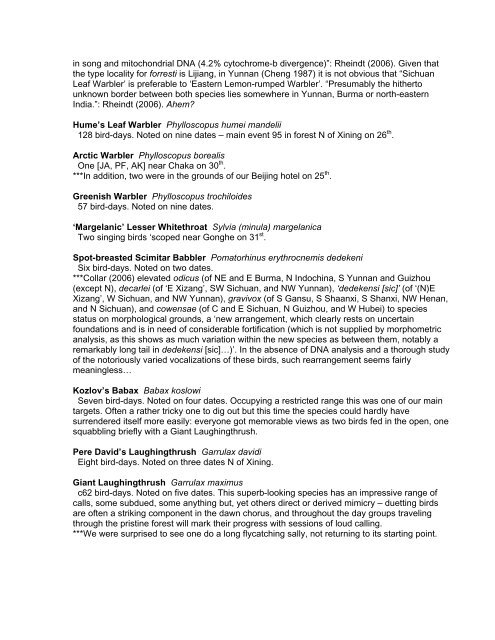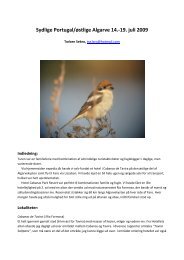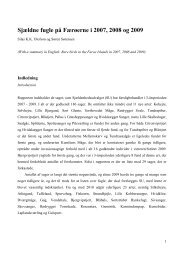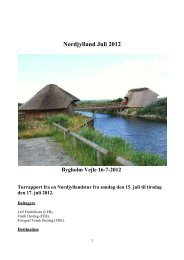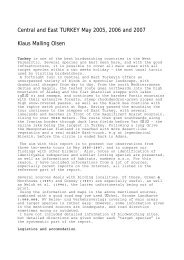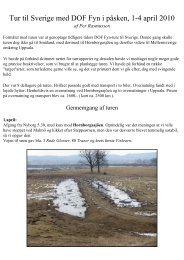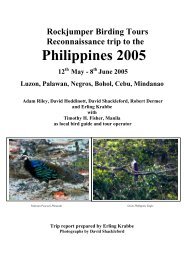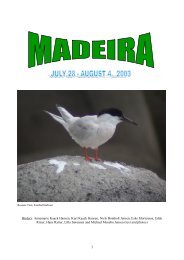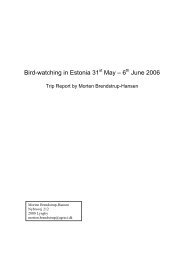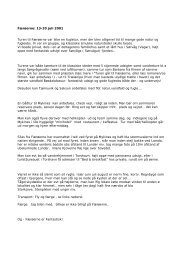NE Tibet with OBC, 3-20 August 2005 - Netfugl.dk
NE Tibet with OBC, 3-20 August 2005 - Netfugl.dk
NE Tibet with OBC, 3-20 August 2005 - Netfugl.dk
You also want an ePaper? Increase the reach of your titles
YUMPU automatically turns print PDFs into web optimized ePapers that Google loves.
in song and mitochondrial DNA (4.2% cytochrome-b divergence)”: Rheindt (<strong>20</strong>06). Given that<br />
the type locality for forresti is Lijiang, in Yunnan (Cheng 1987) it is not obvious that “Sichuan<br />
Leaf Warbler’ is preferable to ‘Eastern Lemon-rumped Warbler’. “Presumably the hitherto<br />
unknown border between both species lies somewhere in Yunnan, Burma or north-eastern<br />
India.”: Rheindt (<strong>20</strong>06). Ahem<br />
Hume’s Leaf Warbler Phylloscopus humei mandelii<br />
128 bird-days. Noted on nine dates – main event 95 in forest N of Xining on 26 th .<br />
Arctic Warbler Phylloscopus borealis<br />
One [JA, PF, AK] near Chaka on 30 th .<br />
***In addition, two were in the grounds of our Beijing hotel on 25 th .<br />
Greenish Warbler Phylloscopus trochiloides<br />
57 bird-days. Noted on nine dates.<br />
‘Margelanic’ Lesser Whitethroat Sylvia (minula) margelanica<br />
Two singing birds ‘scoped near Gonghe on 31 st .<br />
Spot-breasted Scimitar Babbler Pomatorhinus erythrocnemis dedekeni<br />
Six bird-days. Noted on two dates.<br />
***Collar (<strong>20</strong>06) elevated odicus (of <strong>NE</strong> and E Burma, N Indochina, S Yunnan and Guizhou<br />
(except N), decarlei (of ‘E Xizang’, SW Sichuan, and NW Yunnan), ‘dedekensi [sic]’ (of ‘(N)E<br />
Xizang’, W Sichuan, and NW Yunnan), gravivox (of S Gansu, S Shaanxi, S Shanxi, NW Henan,<br />
and N Sichuan), and cowensae (of C and E Sichuan, N Guizhou, and W Hubei) to species<br />
status on morphological grounds, a ‘new arrangement, which clearly rests on uncertain<br />
foundations and is in need of considerable fortification (which is not supplied by morphometric<br />
analysis, as this shows as much variation <strong>with</strong>in the new species as between them, notably a<br />
remarkably long tail in dedekensi [sic]…)’. In the absence of DNA analysis and a thorough study<br />
of the notoriously varied vocalizations of these birds, such rearrangement seems fairly<br />
meaningless…<br />
Kozlov’s Babax Babax koslowi<br />
Seven bird-days. Noted on four dates. Occupying a restricted range this was one of our main<br />
targets. Often a rather tricky one to dig out but this time the species could hardly have<br />
surrendered itself more easily: everyone got memorable views as two birds fed in the open, one<br />
squabbling briefly <strong>with</strong> a Giant Laughingthrush.<br />
Pere David’s Laughingthrush Garrulax davidi<br />
Eight bird-days. Noted on three dates N of Xining.<br />
Giant Laughingthrush Garrulax maximus<br />
c62 bird-days. Noted on five dates. This superb-looking species has an impressive range of<br />
calls, some subdued, some anything but, yet others direct or derived mimicry – duetting birds<br />
are often a striking component in the dawn chorus, and throughout the day groups traveling<br />
through the pristine forest will mark their progress <strong>with</strong> sessions of loud calling.<br />
***We were surprised to see one do a long flycatching sally, not returning to its starting point.


